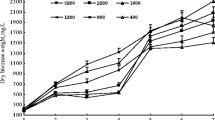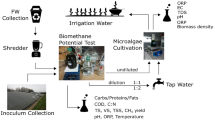Abstract
Ammonia inhibition is considered a key issue when using liquid digestate for microalgae cultivation. To study the effect of pretreatment with a biological aerated filter (BAF) on microalgae culture with dairy liquid digestate, nitrification characteristics of BAFs under different hydraulic retention time (HRT) and the growth characteristics of Chlorella pyrenoidosa in effluents of BAFs were investigated. Results showed that the BAFs can rapidly nitrify ammonia nitrogen and significantly improve the light transmittance of liquid digestate (the maximum promotion rate was ~260%), and the effect improved as the HRT increased. Pretreatment of liquid digestate with BAFs can eliminate ammonia inhibition for C. pyrenoidosa. Furthermore, lipid, crude protein, and higher heating value (HHV) output were also not affected by HRT. The similar removal of nitrate nitrogen in microalgae culture systems using effluents with 6-h and 12-h HRT (21.59% and 21.07%, respectively) were recorded. The results suggested that BAF coupled with microalgae culture is a novel option on the resource utilization of dairy liquid digestate.





Similar content being viewed by others
Availability of data and material
All data generated or analyzed during this study are included in this published article.
Code availability
Not applicable
References
Akerstrom AM, Mortensen LM, Rusten B, Gislerod HR (2014) Biomass production and nutrient removal by Chlorella sp. as affected by sludge liquor concentration. J Environ Manag 144:118–124. https://doi.org/10.1016/j.jenvman.2014.05.015
Ayre JM, Moheimani NR, Borowitzka MA (2017) Growth of microalgae on undiluted anaerobic digestate of piggery effluent with high ammonium concentrations. Algal Res 24:218–226. https://doi.org/10.1016/j.algal.2017.03.023
Cai T, Park SY, Racharaks R, Li YB (2013) Cultivation of Nannochloropsis sauna using anaerobic digestion effluent as a nutrient source for biofuel production. Appl Energy 108:486–492. https://doi.org/10.1016/j.apenergy.2013.03.056
Changpasert W, Wong SL (2020) Optimized process parameters for production of Chlorella pyrenoidosa biomass and lipids using response surface methodology. Aquac Int 28:1213–1226. https://doi.org/10.1007/s10499-020-00522-3
Cheng J, Xu J, Huang Y, Li YY, Zhou JH, Cen KF (2015) Growth optimisation of microalga mutant at high CO2 concentration to purify undiluted anaerobic digestion effluent of swine manure. Bioresour Technol 177:240–246. https://doi.org/10.1016/j.biortech.2014.11.099
Coppens J, Lindeboom R, Muys M, Coessens W, Alloul A, Meerbergen K, Lievens B, Clauwaert P, Boon N, Vlaeminck SE (2016) Nitrification and microalgae cultivation for two-stage biological nutrient valorization from source separated urine. Bioresour Technol 211:41–50. https://doi.org/10.1016/j.biortech.2016.03.001
de Morais MG, Costa JAV (2007) Biofixation of carbon dioxide by Spirulina sp. and Scenedesmus obliquus cultivated in a three-stage serial tubular photobioreactor. J Biotechnol 129:439–445. https://doi.org/10.1016/j.jbiotec.2007.01.009
Dickinson KE, Bjornsson WJ, Garrison LL, Whitney CG, Park KC, Banskota AH, McGinn PJ (2015) Simultaneous remediation of nutrients from liquid anaerobic digestate and municipal wastewater by the microalga Scenedesmus sp. AMDD grown in continuous chemostats. J Appl Microbiol 118:75–83. https://doi.org/10.1111/jam.12681
Ermis H, Altinbas M (2019) Determination of biokinetic coefficients for nutrient removal from anaerobic liquid digestate by mixed microalgae. J Appl Phycol 31:1773–1781. https://doi.org/10.1007/s10811-018-1671-3
Farabegoli G, Chiavola A, Rolle E (2009) The biological aerated filter (BAF) as alternative treatment for domestic sewage. Optimization of plant performance. J Hazard Mater 171:1126–1132. https://doi.org/10.1016/j.jhazmat.2009.06.128
Franchino M, Comino E, Bona F, Riggio VA (2013) Growth of three microalgae strains and nutrient removal from an agro-zootechnical digestate. Chemosphere 92:738–744. https://doi.org/10.1016/j.chemosphere.2013.04.023
Fumasoli A, Bürgmann H, Weissbrodt DG, Wells GF, Beck K, Mohn J, Morgenroth E, Udert KM (2017) Growth of Nitrosococcus-related ammonia oxidizing bacteria coincides with extremely low pH values in wastewater with high ammonia content. Environ Sci Technol 51:6857–6866. https://doi.org/10.1021/acs.est.7b00392
Gustin S, Marinsek-Logar R (2011) Effect of pH, temperature and air flow rate on the continuous ammonia stripping of the anaerobic digestion effluent. Process Saf Environ Prot 89:61–66. https://doi.org/10.1016/j.psep.2010.11.001
He MY, Tan L, Ning SX, Song L, Shi SN (2017) Performance of the biological aerated filter bioaugmented by a yeast Magnusiomyces ingens LH-F1 for treatment of Acid Red B and microbial community dynamics. World J Microbiol Biotechnol 33:39. https://doi.org/10.1007/s11274-017-2210-0
Huo SH, Wang ZM, Zhu SN, Zhou WZ, Dong RJ, Yuan ZH (2012) Cultivation of Chlorella zofingiensis in bench-scale outdoor ponds by regulation of pH using dairy wastewater in winter, South China. Bioresour Technol 121:76–82. https://doi.org/10.1016/j.biortech.2012.07.012
Ji F, Liu Y, Hao R, Li G, Zhou YG, Dong RJ (2014) Biomass production and nutrients removal by a new microalgae strain Desmodesmus sp. in anaerobic digestion wastewater. Bioresour Technol 161:200–207. https://doi.org/10.1016/j.biortech.2014.03.034
Ji F, Zhou YG, Pang AP, Ning L, Rodgers K, Liu Y, Dong RJ (2015) Fed-batch cultivation of Desmodesmus sp. in anaerobic digestion wastewater for improved nutrient removal and biodiesel production. Bioresour Technol 184:116–122. https://doi.org/10.1016/j.biortech.2014.09.144
Jiang YQ, Pu XD, Zheng D, Zhu T, Wang S, Deng LW, Wang WG (2018) Cultivation of lipid-producing microalgae in struvite-precipitated liquid digestate for biodiesel production. Biotechnol Biofuels 11:101. https://doi.org/10.1186/S13068-018-1102-3
Koutra E, Grammatikopoulos G, Kornaros M (2018) Selection of microalgae intended for valorization of digestate from agro-waste mixtures. Waste Manag 73:123–129. https://doi.org/10.1016/j.wasman.2017.12.030
Levine RB, Costanza-Robinson MS, Spatafora GA (2011) Neochloris oleoabundans grown on anaerobically digested dairy manure for concomitant nutrient removal and biodiesel feedstock production. Biomass Bioenergy 35:40–49. https://doi.org/10.1016/j.biombioe.2010.08.035
Liang W, Li Y, Chen P, Min M, Chen Y, Zhu J, Ruan RR (2010) Anaerobic digested dairy manure as a nutrient supplement for cultivation of oil-rich green microalgae Chlorella sp. Bioresour Technol 101:2623–2628. https://doi.org/10.1016/j.biortech.2009.10.062
Luo ZF, Wang DH, Zeng WS, Yang J (2020) Removal of refractory organics from piggery bio-treatment effluent by the catalytic ozonation process with piggery biogas residue biochar as the catalyst. Sci Total Environ 734:139448. https://doi.org/10.1016/j.scitotenv.2020.139448
Markou G, Georgakakis D (2011) Cultivation of filamentous cyanobacteria (blue-green algae) in agro-industrial wastes and wastewaters: a review. Appl Energy 88:3389–3401. https://doi.org/10.1016/j.apenergy.2010.12.042
Mokashi K, Shetty V, George SA, Sibi G (2016) Sodium bicarbonate as inorganic carbon source for higher biomass and lipid production integrated carbon capture in Chlorella vulgaris. Achiev Life Sci 10:111–117. https://doi.org/10.1016/j.als.2016.05.011
Monlau F, Sambusiti C, Ficara E, Aboulkas A, Barakat A, Carrere H (2015) New opportunities for agricultural digestate valorization: current situation and perspectives. Energy Environ Sci 8:2600–2621. https://doi.org/10.1039/c5ee01633a
Park J, Jin HF, Lim BR, Park KY, Lee K (2010) Ammonia removal from anaerobic digestion effluent of livestock waste using green alga Scenedesmus sp. Bioresour Technol 101:8649–8657. https://doi.org/10.1016/j.biortech.2010.06.142
Peccia J, Haznedaroglu B, Gutierrez J, Zimmerman JB (2013) Nitrogen supply is an important driver of sustainable microalgae biofuel production. Trends Biotechnol 31:134–138. https://doi.org/10.1016/j.tibtech.2013.01.010
Pedruzi G, Amorim ML, Santos RR, Martins MA, Vaz M (2020) Biomass accumulation-influencing factors in microalgae farms. Revista Brasileira de Engenharia Agrícola e Ambiental 24:134–139. https://doi.org/10.1590/1807-1929/agriambi.v24n2p134-139
Praveen P, Guo YC, Kang H, Lefebvre C, Loh KC (2018) Enhancing microalgae cultivation in anaerobic digestate through nitrification. Chem Eng J 354:905–912. https://doi.org/10.1016/j.cej.2018.08.099
Qin L, Wang Z, Sun Y, Shu Q, Feng P, Zhu L, Xu J, Yuan Z (2016) Microalgae consortia cultivation in dairy wastewater to improve the potential of nutrient removal and biodiesel feedstock production. Environ Sci Pollut Res 23:8379–8387. https://doi.org/10.1007/s11356-015-6004-3
Qin L, Liu L, Wang Z, Chen W, Wei D (2018) Efficient resource recycling from liquid digestate by microalgae-yeast mixed culture and the assessment of key gene transcription related to nitrogen assimilation in microalgae. Bioresour Technol 264:90–97. https://doi.org/10.1016/j.biortech.2018.05.061
Qin L, Liu L, Wang Z, Chen W, Wei D (2019) The mixed culture of microalgae Chlorella pyrenoidosa and yeast Yarrowia lipolytica for microbial biomass production. Bioprocess Biosyst Eng 42:1409–1419. https://doi.org/10.1007/s00449-019-02138-1
Rajagopal R, Masse DI, Singh G (2013) A critical review on inhibition of anaerobic digestion process by excess ammonia. Bioresour Technol 143:632–641. https://doi.org/10.1016/j.biortech.2013.06.030
Sampathkumar SJ, Gothandam KM (2019) Sodium bicarbonate augmentation enhances lutein biosynthesis in green microalgae Chlorella pyrenoidosa. Biocatal Agric Biotechnol 22:101406. https://doi.org/10.1016/j.bcab.2019.101406
Sayedin F, Kermanshahi-pour A, He QS, Tibbetts SM, Lalonde CGE, Brar SK (2020) Microalgae cultivation in thin stillage anaerobic digestate for nutrient recovery and bioproduct production. Algal Res 47:101867. https://doi.org/10.1016/J.Algal.2020.101867
Singh M, Reynolds DL, Das KC (2011) Microalgal system for treatment of effluent from poultry litter anaerobic digestion. Bioresour Technol 102:10841–10848. https://doi.org/10.1016/j.biortech.2011.09.037
Tan X, Chu H, Zhang Y, Yang L, Zhao F, Zhou X (2014) Chlorella pyrenoidosa cultivation using anaerobic digested starch processing wastewater in an airlift circulation photobioreactor. Bioresour Technol 170:538–548. https://doi.org/10.1016/j.biortech.2014.07.086
Tao R, Lakaniemi A-M, Rintala JA (2017) Cultivation of Scenedesmus acuminatus in different liquid digestates from anaerobic digestion of pulp and paper industry biosludge. Bioresour Technol 245:706–713. https://doi.org/10.1016/j.biortech.2017.08.218
Uggetti E, Sialve B, Latrille E, Steyer JP (2014) Anaerobic digestate as substrate for microalgae culture: the role of ammonium concentration on the microalgae productivity. Bioresour Technol 152:437–443. https://doi.org/10.1016/j.biortech.2013.11.036
Wang LA, Wang YK, Chen P, Ruan R (2010) Semi-continuous cultivation of Chlorella vulgaris for treating undigested and digested dairy manures. Appl Biochem Biotechnol 162:2324–2332. https://doi.org/10.1007/s12010-010-9005-1
Wang J, Zhou W, Chen H, Zhan J, He CL, Wang Q (2019) Ammonium nitrogen tolerant Chlorella strain screening and its damaging effects on photosynthesis. Front Microbiol 9:3250. https://doi.org/10.3389/Fmicb.2018.03250
Xia A, Murphy JD (2016) Microalgal cultivation in treating liquid digestate from biogas systems. Trends Biotechnol 34(4):264–275. https://doi.org/10.1016/j.tibtech.2015.12.010
Xu J, Zhao YJ, Zhao GH, Zhang H (2015) Nutrient removal and biogas upgrading by integrating freshwater algae cultivation with piggery anaerobic digestate liquid treatment. Appl Microbiol Biotechnol 99:6493–6501. https://doi.org/10.1007/s00253-015-6537-x
Xu X, Martin GJO, Kentish SE (2019) Enhanced CO2 bio-utilization with a liquid-liquid membrane contactor in a bench-scale microalgae raceway pond. J CO2 Util 34:207–214. https://doi.org/10.1016/j.jcou.2019.06.008
Xu J, Zhu SN, Mo NM, Wang ZM, Zeng EY (2020) Screening of freshwater oleaginous microalgae from South China and its cultivation characteristics in energy grass digestate. J Clean Prod 276:124193. https://doi.org/10.1016/j.jclepro.2020.124193
Yang LB, Tan XB, Li DY, Chu HQ, Zhou XF, Zhang YL, Yu H (2015) Nutrients removal and lipids production by Chlorella pyrenoidosa cultivation using anaerobic digested starch wastewater and alcohol wastewater. Bioresour Technol 181:54–61. https://doi.org/10.1016/j.biortech.2015.01.043
Yang YY, Chen ZG, Wang XJ, Zheng L, Gu XY (2017) Partial nitrification performance and mechanism of zeolite biological aerated filter for ammonium wastewater treatment. Bioresour Technol 241:473–481. https://doi.org/10.1016/j.biortech.2017.05.151
Zhang L, Cheng J, Pei H, Pan J, Jiang L, Hou Q, Han F (2018) Cultivation of microalgae using anaerobically digested effluent from kitchen waste as a nutrient source for biodiesel production. Renew Energy 115:276–287. https://doi.org/10.1016/j.renene.2017.08.034
Zhao YJ, Sun SQ, Hu CW, Zhang H, Xu J, Ping LF (2015) Performance of three microalgal strains in biogas slurry purification and biogas upgrade in response to various mixed light-emitting diode light wavelengths. Bioresour Technol 187:338–345. https://doi.org/10.1016/j.biortech.2015.03.130
Zhu WL, Cui LH, Ouyang Y, Long CF, Tang XD (2011) Kinetic adsorption of ammonium nitrogen by substrate materials for constructed wetlands. Pedosphere 21:454–463. https://doi.org/10.1016/S1002-0160(11)60147-1
Zhu S, Qin L, Feng P, Shang C, Wang Z, Yuan Z (2019) Treatment of low C/N ratio wastewater and biomass production using co-culture of Chlorella vulgaris and activated sludge in a batch photobioreactor. Bioresour Technol 274:313–320. https://doi.org/10.1016/j.biortech.2018.10.034
Acknowledgements
The authors are grateful to Mohammad Asraful Alam for his kind help in English editing.
Funding
This work was supported by the Science and Technology Planning Project of Guangzhou (202102080406), the National Natural Science Foundation of China (21606230 and 21878291), Opening Foundation of Henan Key Laboratory of Industrial Microbial Resources and Fermentation Technology (HIMFT20190203), and the Natural Science Foundation for Research Team of Guangdong Province (2016A030312007).
Author information
Authors and Affiliations
Contributions
Lei Qin and Bo Wang carried out the experiments and wrote the manuscript. Pinzhong Feng and Yinghan Cao analyzed the data. Zhongming Wang and Shunni Zhu supervised the experimental work and revised the manuscript.
Corresponding authors
Ethics declarations
Ethics approval
Not applicable
Consent to participate
Not applicable
Consent for publication
Not applicable
Competing interests
The authors declare no competing interests.
Additional information
Responsible Editor: Philippe Garrigues
Publisher’s note
Springer Nature remains neutral with regard to jurisdictional claims in published maps and institutional affiliations.
Rights and permissions
About this article
Cite this article
Qin, L., Wang, B., Feng, P. et al. Treatment and resource utilization of dairy liquid digestate by nitrification of biological aerated filter coupled with assimilation of Chlorella pyrenoidosa. Environ Sci Pollut Res 29, 3406–3416 (2022). https://doi.org/10.1007/s11356-021-15903-1
Received:
Accepted:
Published:
Issue Date:
DOI: https://doi.org/10.1007/s11356-021-15903-1




